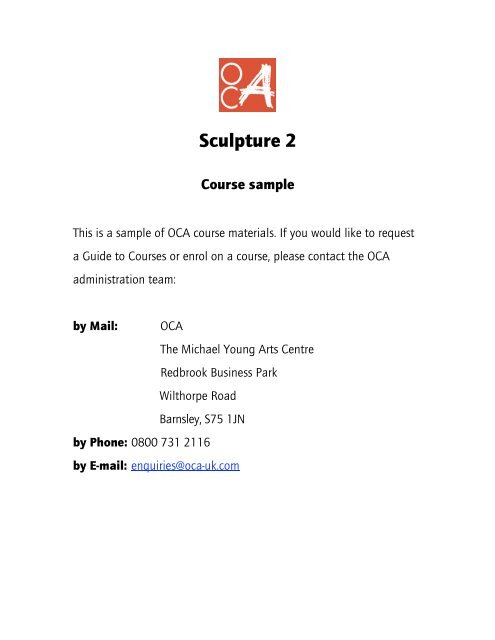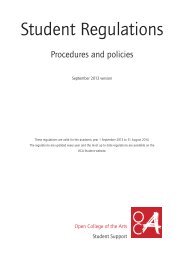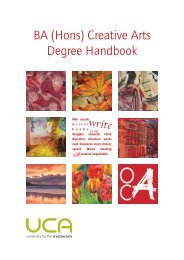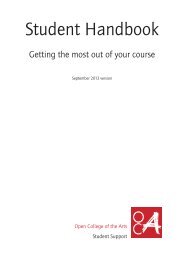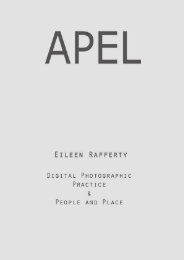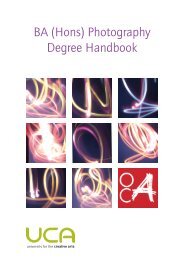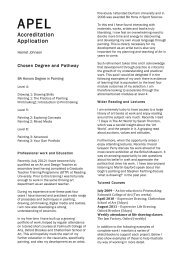Sculpture 2 - Course Sample - the Open College of the Arts
Sculpture 2 - Course Sample - the Open College of the Arts
Sculpture 2 - Course Sample - the Open College of the Arts
You also want an ePaper? Increase the reach of your titles
YUMPU automatically turns print PDFs into web optimized ePapers that Google loves.
<strong>Sculpture</strong> 2<br />
<strong>Course</strong> sample<br />
This is a sample <strong>of</strong> OCA course materials. If you would like to request<br />
a Guide to <strong>Course</strong>s or enrol on a course, please contact <strong>the</strong> OCA<br />
administration team:<br />
by Mail: OCA<br />
The Michael Young <strong>Arts</strong> Centre<br />
Redbrook Business Park<br />
Wilthorpe Road<br />
Barnsley, S75 1JN<br />
by Phone: 0800 731 2116<br />
by E-mail: enquiries@oca-uk.com
<strong>Sculpture</strong> 2<br />
Written by: Chris Sacker<br />
Level HE5 - 60 CATS
<strong>Open</strong> <strong>College</strong> <strong>of</strong> <strong>the</strong> <strong>Arts</strong><br />
Unit 1B, Redbrook Business Park<br />
Wilthorpe Road<br />
Barnsley<br />
S75 1JN<br />
Telephone: 0800 731 2116<br />
Fax: 01226 730 838<br />
E - mail: enquiries@oca-uk.com<br />
www.oca-uk.com<br />
Registered charity number: 327446<br />
OCA is a company limited by guarantee and<br />
registered in England under number 2125674<br />
Copyright OCA 2008<br />
Document control number: S1.doc<br />
Cover image: ‘Surveillance’ (detail) Wood and Acrylic Paint 2008<br />
No part <strong>of</strong> this publication may be reproduced, stored in a retrieval system, or<br />
transmitted in any form or by any means - electronic, mechanical, photocopy,<br />
recording or o<strong>the</strong>rwise - without prior permission <strong>of</strong> <strong>the</strong> publisher<br />
(<strong>Open</strong> <strong>College</strong> <strong>of</strong> <strong>the</strong> <strong>Arts</strong>)
About <strong>the</strong> author<br />
Chris Sacker is a pr<strong>of</strong>essional practicing and exhibiting Fine Artist, who since<br />
1976 been a visiting lecturer in Fine Art and <strong>Sculpture</strong> in art schools and<br />
universities in Great Britain and Europe. Amongst <strong>the</strong>se, include Edinburgh<br />
School <strong>of</strong> Art, Dartington <strong>College</strong>, University <strong>of</strong> Hull, Academy <strong>of</strong> Fine <strong>Arts</strong>,<br />
Vienna and <strong>the</strong> Accaademia di Belle Arti, Perugia, Italy.<br />
During <strong>the</strong> late 1980s and throughout <strong>the</strong> 1990s he was Assistant <strong>Sculpture</strong><br />
Consultant, Education Co-ordinator and Lecturer for <strong>the</strong> Henry Moore <strong>Sculpture</strong><br />
Studio in Halifax, where major International Sculptors where invited to make<br />
new innovative works for <strong>the</strong> Henry Moore Foundation. In this capacity he<br />
lectured to B.A. M.A. and PhD students from <strong>the</strong> majority <strong>of</strong> art colleges in<br />
Britain on <strong>the</strong> projects <strong>of</strong> <strong>the</strong> invited artists.
Over <strong>the</strong> past 20 years, he has been interviewed on many occasions on radio and<br />
television in relation to his own practice as an artist and that <strong>of</strong> International<br />
Contemporary Sculptors, including Radio 4 ‘ Kaleidoscope’, Radio 3<br />
‘Nightwaves’, The <strong>Arts</strong> Channel, and Yorkshire Television.<br />
Chris has also taken part in a number <strong>of</strong> International sculpture conferences in<br />
Italy on ‘Contemporary British <strong>Sculpture</strong>’ ‘Old Age and Creativity’ and<br />
‘Transformations <strong>of</strong> Art at <strong>the</strong> Turn <strong>of</strong> <strong>the</strong> 20 th Century’.<br />
Chris was co-designer and editor <strong>of</strong> <strong>the</strong> book ‘<strong>Sculpture</strong> on <strong>the</strong> Page’ [drawings<br />
and text] by Tony Cragg, published by <strong>the</strong> Whitechapel Gallery and <strong>the</strong> Henry<br />
Moore Trust.<br />
With his own practice, since graduating in 1973, Chris has exhibited his work in<br />
galleries and museums, nationally and internationally including Britain, France,<br />
Germany, Italy, Israel and <strong>the</strong> Ukraine.<br />
Recent major exhibitions include; <strong>the</strong> Biennale <strong>of</strong> Florence and <strong>the</strong> X11 Biennale<br />
<strong>of</strong> <strong>Sculpture</strong> in Cararra, Italy.<br />
Chris’s work is held in a number <strong>of</strong> major museums and collections which<br />
Include; Museo Luigi Pecci, Prato and Museo di Scultura, Cararra, Italy.
Contents<br />
Introduction<br />
<strong>Course</strong> overview<br />
Photography<br />
<strong>Course</strong> outcomes<br />
Health & Safety considerations<br />
Project and assignment plan<br />
1: A proposal for a public sculpture<br />
Introduction<br />
Project 1: Site selection, context and form <strong>of</strong> <strong>the</strong> work<br />
Project 2: Drawings/selection <strong>of</strong> materials for <strong>the</strong> proposed<br />
sculpture<br />
Project 3: Logistical conciderations<br />
Project 4: Maquette for a Public <strong>Sculpture</strong> Commission<br />
Assignment 1: Sculptural form as Architecture/ Architecture form as<br />
<strong>Sculpture</strong>: A maquette for a monumental sculpture<br />
2: Planes: construction / deconstruction<br />
Introduction<br />
Project 5: Drawing and development<br />
Project 6: A maquette for a sculpture<br />
Project 7: A larger- scale sculpture constructed <strong>of</strong> planes<br />
Assignment 2: Deconstruction/Construction<br />
3: Organic abstraction / natural form<br />
Introduction<br />
Project 8: A modelled organic abstraction <strong>of</strong> <strong>the</strong> human form<br />
Project 9: Natural form: a direct abstract carving
Assignment 3: Your own natural form/organic abstraction sculpture<br />
4: The monument<br />
Introduction<br />
Project 10: The monument: research and development<br />
Project 11: A monument/maquettes<br />
Assignment 4: A monument to a personal hero<br />
5: Your own content, materials, techniques and<br />
sculpture<br />
Introduction<br />
Project 12: Research/aims and perceived outcomes and<br />
developmental drawings<br />
Project 13: Maquettes/different possibilities/materials and<br />
techniques<br />
Assignment 5: Your own sculpture/sculptures<br />
Appendix A: Glossary <strong>of</strong> terms<br />
Appendix B: Suggested reading
Introduction<br />
<strong>Course</strong> overview<br />
You will now have had <strong>the</strong> experience <strong>of</strong> <strong>the</strong> main techniques in <strong>the</strong> art <strong>of</strong><br />
building sculpture: construction, modelling, casting and carving.<br />
<strong>Sculpture</strong> 1 took you through a series <strong>of</strong> projects and assignments that we hope<br />
gave you a comprehensive insight into <strong>the</strong> sculptural techniques and related<br />
aspects <strong>of</strong> <strong>the</strong> history <strong>of</strong> <strong>the</strong> subject <strong>of</strong> sculpture.<br />
We hope it has helped you gain confidence, knowledge and understanding <strong>of</strong> <strong>the</strong><br />
subject <strong>of</strong> sculpture.<br />
<strong>Sculpture</strong> 2 is designed to build on your experiences that you gained in <strong>the</strong><br />
previous course, giving you <strong>the</strong> opportunity to work more ambitiously and<br />
independently as a student, this will be done by asking you to choose your<br />
projects and <strong>the</strong> way that you deal with <strong>the</strong>m in three-dimensional terms by<br />
developing your own ideas from <strong>the</strong> project briefs and assignments that will be<br />
set.<br />
This course aims for you, as a motivated and confident student, to approach <strong>the</strong><br />
experience <strong>of</strong> sculpture, new techniques and skills with a broader range <strong>of</strong><br />
sculptural materials, increasing your independence and self-motivation as a<br />
sculptor.<br />
Throughout this course you are encouraged to consider some <strong>of</strong> <strong>the</strong> <strong>the</strong>ories that<br />
have emerged within modern sculptural practice during <strong>the</strong> 20 th century.
Health & Safety<br />
It is important for you to write your own risk assessment prior to commencing<br />
any practical studio work and consider what personal protection you will require<br />
for each <strong>of</strong> <strong>the</strong> tasks.<br />
You will also be required to write ‘project commentaries’. These will take <strong>the</strong><br />
form <strong>of</strong> self-appraisals, (your aims and objectives and success <strong>of</strong> your outcomes<br />
for each <strong>of</strong> <strong>the</strong> projects) in relation to your work and will be presented to your<br />
tutor for comment.<br />
There is also a written element to <strong>the</strong> <strong>Sculpture</strong> 2 course in <strong>the</strong> form <strong>of</strong> an<br />
extended essay <strong>of</strong> approximately 2000 words. This should take <strong>the</strong> form <strong>of</strong> a<br />
critical review <strong>of</strong> a contemporary work/movement or a critical essay on a<br />
sculptor that you will choose to complement your programme <strong>of</strong> practical work.<br />
The format <strong>of</strong> this essay will be discussed in consultation with your tutor, who<br />
will direct you in subject choice and <strong>the</strong> content <strong>of</strong> your essay. This is all part <strong>of</strong><br />
your development, as <strong>the</strong> contextualisation <strong>of</strong> your work is an important part <strong>of</strong><br />
your activity as a sculptor.<br />
During <strong>the</strong> first year <strong>of</strong> your course, you were confronting <strong>the</strong> basic problems <strong>of</strong><br />
sculptural activity in relation to <strong>the</strong> methods and techniques <strong>of</strong> composing and<br />
building three-dimensional form and solving <strong>the</strong> physical problems which occur<br />
in <strong>the</strong> making <strong>of</strong> sculpture, ra<strong>the</strong>r than what you were trying to develop in <strong>the</strong><br />
content <strong>of</strong> your work. You were focussing on <strong>the</strong> ‘hows’ ra<strong>the</strong>r than <strong>the</strong> ‘whys’ <strong>of</strong><br />
producing sculpture.<br />
During <strong>Sculpture</strong> 2, we would like you to develop <strong>the</strong> idea <strong>of</strong> <strong>the</strong> ‘whys’ (<strong>the</strong><br />
content <strong>of</strong> your work). These include choice <strong>of</strong> subject matter, <strong>the</strong> form <strong>of</strong> your<br />
sculpture, your materials, methods and techniques <strong>of</strong> production, how you make<br />
<strong>the</strong> decisions within your sculptural practice, and your work in relation to that <strong>of</strong><br />
o<strong>the</strong>r sculptors through <strong>the</strong> contextualisation <strong>of</strong> your sculptural practice.
The sculptor Reg Butler once said “Creative development is directly proportional<br />
to <strong>the</strong> exposure to art, both past and present”.<br />
We would also like to emphasise <strong>the</strong> importance <strong>of</strong> experimentation in all your<br />
developmental work. Sometimes, through this process, new lines <strong>of</strong> enquiry can<br />
be explored and decisions can be made. Occasionally <strong>the</strong>re are ‘happy accidents’<br />
which can give you a different aspect on <strong>the</strong> forms that you create, which can be<br />
developed fur<strong>the</strong>r.<br />
Throughout <strong>Sculpture</strong> 1, you may have been exposed to styles and sculptural<br />
form, some <strong>of</strong> which will have excited you as a student and to techniques that<br />
you feel very comfortable with as an individual and you may now feel that you<br />
wish to develop fur<strong>the</strong>r in a much more ambitious and individual way.<br />
As you progress through <strong>Sculpture</strong> 2, you will be given <strong>the</strong> opportunity to<br />
develop <strong>the</strong> idea <strong>of</strong> <strong>the</strong> ‘whys’ in relation to <strong>the</strong> content <strong>of</strong> your work and <strong>the</strong><br />
‘hows’ in relation to <strong>the</strong> production <strong>of</strong> your sculptural form.<br />
In many ways <strong>Sculpture</strong> 2 is less prescriptive about <strong>the</strong> content and production<br />
<strong>of</strong> your work, giving you a much more individual and independent approach to<br />
your own sculptural activity.
1: A proposal for a public sculpture<br />
Introduction<br />
Throughout art history sculptors have made works which have existed in <strong>the</strong><br />
public domain, from <strong>the</strong> colossal temple monuments <strong>of</strong> ancient Egypt and<br />
Greece, Rome’s ‘Trajans Column’ celebrating <strong>the</strong> victories <strong>of</strong> <strong>the</strong> Dacian Wars,<br />
<strong>the</strong> heroic bronze statue <strong>of</strong> ‘Marcus Aurelius’ on <strong>the</strong> Capitaline Hill, <strong>the</strong><br />
Renaissance fountains and public works in <strong>the</strong> piazzas <strong>of</strong> Rome, through to <strong>the</strong><br />
war memorials <strong>of</strong> <strong>the</strong> 20 th century, commissioned by civic authorities as a<br />
country’s expression <strong>of</strong> loss.<br />
The Roman army crossing <strong>the</strong> Danube, detail from Trajan's Column<br />
At <strong>the</strong> end <strong>of</strong> <strong>the</strong> 20 th century/beginning <strong>of</strong> <strong>the</strong> 21 st century, contemporary public<br />
sculpture has once again come to <strong>the</strong> fore, with more commissions for sculpture<br />
by public and corporate funding <strong>of</strong> <strong>the</strong> arts. At this moment in time, <strong>the</strong>re
appears to be three types <strong>of</strong> public sculpture, all <strong>of</strong> which are site-specific in <strong>the</strong>ir<br />
conceptual nature: public sculpture which commemorates events in <strong>the</strong> context<br />
<strong>of</strong> <strong>the</strong>ir conception, sculptures that are commissioned for <strong>the</strong>ir aes<strong>the</strong>tic<br />
enhancement <strong>of</strong> a public space and o<strong>the</strong>r work commissioned from sculptors that<br />
are designed to fit into civic situations and facilitate social interaction – <strong>the</strong>se are<br />
usually collaborations between artists and architects.<br />
The architectural scale <strong>of</strong> sculpture had intrigued sculptors even at <strong>the</strong> beginning<br />
<strong>of</strong> <strong>the</strong> 20 th century. ‘The Monument to <strong>the</strong> Third International’ 1919-1920 by <strong>the</strong><br />
Russian Constructivist Vladimir Tatlin was intended to be on a huge scale, twice<br />
<strong>the</strong> size <strong>of</strong> <strong>the</strong> Empire State Building in New York, and in Kasimir Malevich’s<br />
‘Architectonics’ 1924-28 we can see that <strong>the</strong> sculptural composition derived from<br />
cuboid forms has aspirations <strong>of</strong> a large-scale work, possibly for <strong>the</strong> public<br />
domain.<br />
Two contemporary examples <strong>of</strong> large-scale public sculpture that fall into <strong>the</strong><br />
category <strong>of</strong> commemoration are Antony Gormley’s (1950-) ‘Angel <strong>of</strong> <strong>the</strong> North’<br />
1998, a monumental cast-iron figure with a 54 m wingspan, which stands<br />
overlooking <strong>the</strong> A1 near Gateshead, on <strong>the</strong> site <strong>of</strong> a disused colliery, and pays<br />
tribute to <strong>the</strong> industrial heritage <strong>of</strong> <strong>the</strong> North-East.<br />
Jaume Plensa’s (1954-) ‘Breathing’ 2008, for <strong>the</strong> BBC at Broadcasting House in<br />
London, is a sculpture shaped in <strong>the</strong> form <strong>of</strong> a giant inverted glass spire 10 m<br />
high, with a poetic text etched around <strong>the</strong> sculpture in a spiral to evoke <strong>the</strong><br />
<strong>the</strong>mes <strong>of</strong> speech, silence, life and death and, during <strong>the</strong> hours <strong>of</strong> darkness, a<br />
beam <strong>of</strong> light is projected 900 m into <strong>the</strong> night sky. The work is a memorial to <strong>the</strong><br />
journalists who have lost <strong>the</strong>ir lives around <strong>the</strong> world.<br />
<strong>Sculpture</strong>s are also commissioned for <strong>the</strong>ir aes<strong>the</strong>tic enhancement <strong>of</strong> public<br />
spaces. A number <strong>of</strong> examples <strong>of</strong> <strong>the</strong>se can be seen in London. Two such<br />
examples are Richard Serra’s (1939-) ‘Fulcrum’ 1987, which is a huge abstract<br />
geometric sculpture, made from sheets <strong>of</strong> Cor-ten steel, sited it <strong>the</strong> Broadgate
Complex, London EC2 and Henry Moore’s (1898-1986) ‘Knife Edge, Two Pieces’<br />
1962, in bronze, which is opposite <strong>the</strong> House <strong>of</strong> Lords.<br />
Henry Moore appears to be <strong>the</strong> forerunner <strong>of</strong> <strong>the</strong> commissioned public sculptor<br />
in <strong>the</strong> 20 th century and produced large-scale works for public spaces. His work<br />
can be seen in many cities throughout <strong>the</strong> world and in this country in cities such<br />
as York, Leeds and London.<br />
Since 1999, <strong>the</strong> vacant fourth plinth in Trafalgar Square, London, which was<br />
originally intended to support a statue <strong>of</strong> William IV, is a site where sculptors<br />
have been commissioned on an annual basis to create a work for <strong>the</strong> site. In 2007<br />
Thomas Schutte (0000-) created ‘Hotel for Birds’ (a response to <strong>the</strong> pigeons which<br />
inhabit <strong>the</strong> square), a construction <strong>of</strong> interlocking, multi-coloured Perspex boxes.<br />
The collaboration between sculptors and architects in <strong>the</strong> latter part <strong>of</strong> <strong>the</strong> 20 th<br />
century has become more established. A major collaboration took place during<br />
2000, when <strong>the</strong> sculptor Sir Anthony Caro, <strong>the</strong> architect Sir Norman Foster and<br />
<strong>the</strong> engineers Arup and Partners won <strong>the</strong> competition to design and build <strong>the</strong><br />
330 m ‘Millennium Bridge’, which links <strong>the</strong> City <strong>of</strong> London and <strong>the</strong> Tate Modern<br />
on Bankside across <strong>the</strong> Thames. Even though this is a practical, functioning<br />
bridge, which affords social interaction between communities, it not only<br />
functions as a bridge but as an interactive sculpture.<br />
In this set <strong>of</strong> projects and assignment, you are asked to design a public sculpture,<br />
which should be site-specific and have reference commemoratively, aes<strong>the</strong>tically<br />
or socially interactive to <strong>the</strong> site that you choose to exhibit <strong>the</strong> work. Of course,<br />
this is only a proposal and should result in a maquette <strong>of</strong> <strong>the</strong> final work that you<br />
propose.
Health & Safety<br />
It is important for you to write your own risk assessment prior to commencing<br />
any practical studio work and to consider what personal protection you will<br />
require for each <strong>of</strong> your tasks.<br />
Project 1: Site selection, context and form <strong>of</strong> <strong>the</strong><br />
work<br />
Introduction<br />
Your first task is to select a site for your proposed sculpture. This could be a<br />
public square, an open space in front <strong>of</strong> a civic building or in a public park. The<br />
choice <strong>of</strong> site is entirely yours, but we feel it would be more <strong>of</strong> a challenge to set<br />
your work in a man-made environment, where it could harmonise or compete<br />
with its surroundings.<br />
The selection <strong>of</strong> your site should depend on much more than its visual appeal.<br />
You should research into <strong>the</strong> context <strong>of</strong> <strong>the</strong> site you have selected with regard to<br />
its significance historically, emotionally, socially etc. This may be <strong>of</strong> help in<br />
formulating your ideas in relation to <strong>the</strong> content and form <strong>of</strong> your work: is it to<br />
be commemorative? Is it to be an aes<strong>the</strong>tic imposition on <strong>the</strong> site? Is it to be<br />
functional and socially interactive? These are all questions you should be asking<br />
yourself when making your decisions.<br />
Once you have selected your site, make photographs and drawings <strong>of</strong> <strong>the</strong><br />
surroundings for your studio reference. Try to make <strong>the</strong>se as comprehensive as<br />
possible, including approximate measurements <strong>of</strong> <strong>the</strong> site, as your final proposal<br />
has to have scale in relation to <strong>the</strong> site and <strong>the</strong> maquette that you produce.
Antony Gormley<br />
Angel <strong>of</strong> <strong>the</strong> North, Iron 1998


